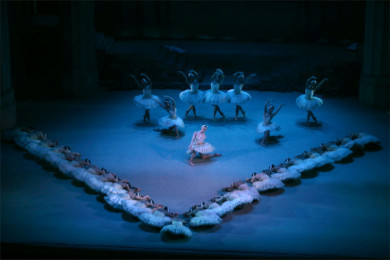, the treasure of the Russian Classical Ballet ballet, form the basis of the classical ballet repertoire of the Mariinsky Theater: more than a hundred years ago, it was choreographed by
and is considered to be a hallmark of the Mariinsky Ballet - the Main Ballet Stage of the Russian Empire. This classical masterpiece was performed almost uncountable number of times at the Mariinsky Theatre and in the course of numerous tours.
Libretto - Vladimir Begichev, Vasily Geltzer
Costume design: Galina Solovyova
World premiere: 20 February 1877, Bolshoi Theatre, Moscow (choreography by Julius Reisinger)
Premiere in St Petersburg: 15 January 1895, Mariinsky Theatre (choreography by Lev Ivanov and Marius Petipa)
Premiere of Konstantin Sergeyev’s version: 8 March 1950, Kirov Theatre, Leningrad
“Swan Lake”
It is difficult to understand these days how it could have happened that the first show of the “Lake” in 1877, in Moscow’s Bolshoi, was a flop, and that it took many years for the ballet to achieve its worldwide cult status. The composer, Pyotr Ilych Tchaikovsky, never lived to see the ultimate success of his creation.
The story begins in 1875, when Bolshoi commissions a ballet score from the young but already famous composer. It was not yet customary practice –despite Tchaikovsky fame and previous successes, which included four symphonies, the now famous Piano Concerto and “Eugene Onegin” opera, the Imperial Theatres of the time would normally employ the composers on Imperial payroll, such as Cesare Pugni, Ludwig Minkus, and Riccardo Drigo. Keeping that in mind, Tchaikovsky did not embark on the course of a revolution in the Russian ballet, and studied the classic ballet scores assiduously, planning to produce a score that would be in tune with the established tradition but at the same time would sound new and interesting. The task of composition occupied him from May 1875 to April 1876. The story was a knightly fairy tale, and historians still debate the literary origins –some opt for Heine, some for Musaeus, a German fairy-tale writer, some for Russian folklore fairy tales, some even for Pushkin.
The first show took place on February 20, 1877, and was a flop. The critics reviled the chief choreographer, Wentsel Reisinger, and were short on praise for Polina (Pelageya) Karpakova, the first interpreter of the main female part. The failure of the first show was detrimental for the immediate reputation of the ballet itself, and for quite some time nobody dared to stage it again.
The situation changed after Tchaikovsky’s death. In 1893, Mariinka decided to revive the “Swan Lake”. A new version of the libretto and the music was to be produced by Modest Tchaikovsky, the composer’s brother, Ivan Vsevolzhsky, the director of the Imperial Theatres himself, and by Riccardo Drigo. The latter used the original music as a source material for a completely new score. The choreography was supervised by Marius Petipa and his pupil Lev Ivanov. The tradition claims that while Petipa was the father of the unique choreography of the new ballet, its truly Russian singing character is there thanks to Ivanov. The lake and swan scenes, famous for their perfection, are undoubtedly his alone. It was Ivanov who came up with the idea of enchanted ladies with their criss-crossed arms and heads tilted to one side, which every spectator immediately recognized for birds that sit with their wings folded. The very magical world of the swan lake was created by Ivanov. Petipa’s are the scenes of courtly dances and festivities and their intricate lace of waltzes and various dances – Spanish, Hungarian, Polish. Petipa also created an antipode for Ivanov’s White Queen of Swans –its black twin Odile, and its beautiful black pas-de-deux of the second act.
It was this particular stage version that came to be admired as the pinnacle of Russian ballet. This production, as none other, was the perfect setting for many famous dancers to showcase their art. The Swan Lake is a unique and perfect creation, and despite the changing musical and dancing fashions, the performance of Odette and Odile parts is still considered a touchstone for the mettle of any serious dancer. The White Swan is truly a symbol of Russian Ballet, of its beauty and magnificence.
Photos © 2000-2006 Marc Haegeman © Text 2010 Art and Culture Magazine "St Peterburg"
 Mariinsky Theatre:
Mariinsky Theatre:  Mariinsky-2 (New Theatre):
Mariinsky-2 (New Theatre):  Mariinsky Concert Hall:
Mariinsky Concert Hall: 


